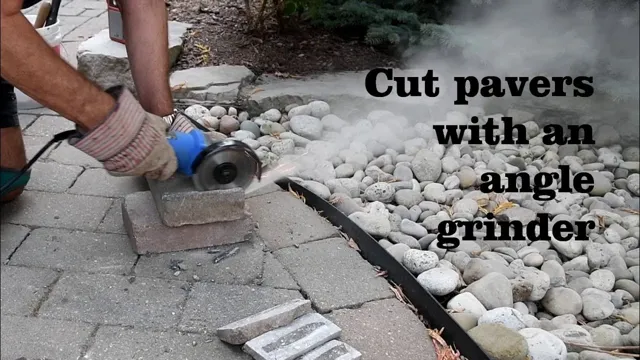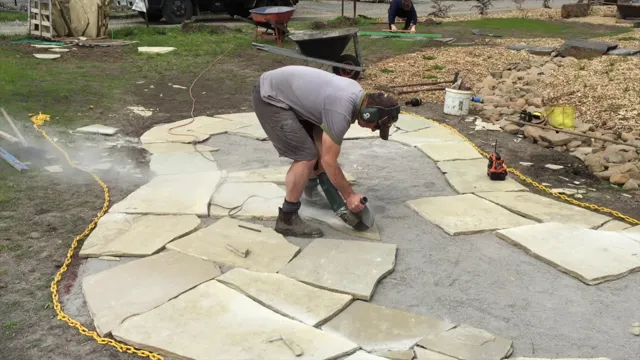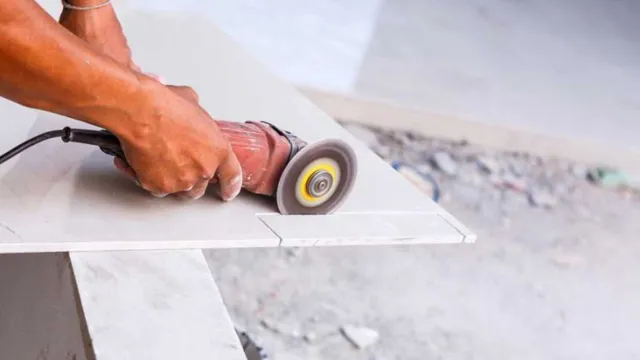How to Cut Concrete Pavers with Angle Grinder: Tips and Tricks

Cutting concrete pavers can be a daunting task, especially when you don’t have the right tools. The good news is that with an angle grinder, you can tackle this job easily and efficiently. An angle grinder is a versatile tool that’s great for cutting, grinding, and polishing, making it a perfect choice when it comes to cutting concrete pavers.
Not only is it easy to use, but it can also help you achieve clean and precise cuts, ensuring that your pavers fit together perfectly. In this blog, we’ll take a closer look at how you can use an angle grinder to cut concrete pavers. Whether you’re a DIY enthusiast or a professional contractor, this guide will help you get the job done right.
So, let’s get started!
What You Will Need
Cutting concrete pavers with an angle grinder is an easy and efficient DIY project that anyone can tackle with the right tools and precautions. Before getting started, gather your supplies, including a diamond blade. Safety gear, such as safety glasses, gloves and a face shield, are also a must.
Part of the preparation involves choosing the right 5″ or 5″ diamond blade for cutting the pavers. The diamond blade’s cutting edge should be at least 1/4 inch bigger than the paver’s thickness.
You will also need a continuous water source to keep the blade cool. With all your tools and materials, you’re ready to dive into the project and cut your concrete pavers with ease using your angle grinder.
Angle Grinder
Angle Grinder An angle grinder is a versatile and essential tool for many DIY projects, and it is a common tool to have in the workshop. Before getting started with using the angle grinder, there are a few things that you will need. Firstly, you will need the angle grinder itself.
Choose the right type of angle grinder for your project, based on the size of the disc and the power of the motor. Secondly, make sure that you have protective gear such as gloves, goggles, and a dust mask to protect yourself from any flying debris. Next, make sure you have the right kind of disc for your project, whether it be a cutting disc or grinding disc.
Finally, you will need to think about the power source for your angle grinder. Depending on the size of your project, you may need a battery-powered or corded angle grinder. Once you have all of these items on hand, you are ready to begin your project using your trusty angle grinder.
Remember to always be safe and use proper technique to avoid accidents or injuries while working.

Diamond Blade
If you’re planning to use a diamond blade for your next project, there are a few things you’ll need to get started. First and foremost, you’ll obviously need a diamond blade. Make sure you choose the right blade for your specific project, as there are different types of blades designed for different materials.
You’ll also need a power saw to attach the blade to. Once you have your blade and saw ready, ensure that you have the proper safety equipment, such as gloves and eye protection. Finally, make sure you have a solid understanding of how to safely operate the saw and blade before you begin.
With all of these elements in place, you’ll be well on your way to making your project a success.
Safety Gear
When it comes to safety gear, it’s important to have the right equipment for the task at hand. Whether you’re working on a construction site, biking down a mountain, or taking part in high-risk activities, certain safety gear is essential. The most important piece of gear is likely a helmet, as head injuries can be life-threatening.
After that, it depends on the activity you’re doing. For construction work, you’ll need steel-toed boots and a hard hat. For biking or skateboarding, knee pads, elbow pads, and wrist guards are a must-have.
When rock climbing or bouldering, you’ll need a harness, climbing rope, and climbing shoes. No matter the activity, always make sure to invest in quality gear and ensure it fits properly. Safety gear is a key factor in preventing injury, so don’t skimp on it.
Preparing for the Cut
If you are planning to cut concrete pavers with an angle grinder, it’s important to prepare yourself and your workspace before getting started. Firstly, make sure you have all the necessary safety equipment, such as eye and ear protection, gloves, and a dust mask. Next, clear the area of any debris or obstacles that may hinder your cutting process.
It’s also helpful to mark the area you’ll be cutting with a pencil or chalk, to ensure accurate cutting. Then, attach a diamond blade to your angle grinder, as this type of blade is specifically designed for cutting through tough materials like concrete. Finally, test the angle grinder on a practice piece of paver, to get a feel for the tool and ensure that the blade is properly aligned.
By preparing properly and taking safety precautions, you’ll be ready to successfully cut your concrete pavers with ease using an angle grinder.
Marking the Cut
When it comes to woodworking, preparing for the cut is just as important as the actual cut itself. One crucial step in the process is marking the cut. This involves measuring and drawing a line or shape on the material that needs to be cut.
The accuracy of this marking will determine the precision of the cut, so it’s essential to take your time and double-check your measurements before making any marks. Using a sharp pencil or marking knife, draw your line with a steady hand. If you’re using a saw, make sure to account for the width of the blade when marking your cut.
Taking shortcuts during this step can lead to costly mistakes, so it’s best to be patient and ensure you have everything correct before moving forward. By taking the time to properly mark your cut, you’ll save yourself time and frustration in the long run.
Securing the Paver
When it comes to laying pavers, securing them becomes an important step. One crucial aspect of securing pavers is preparing for the cut. Before making any cuts, it’s important to measure the area and ensure that all the pavers have been laid out correctly.
This will help to avoid any mistakes that may result in uneven edges or gaps. Once the area has been measured, you can use a chalk line to mark where the cut will be made. It’s important to use a steady hand when making the cut to ensure that it is accurate and straight.
After making the cut, be sure to inspect the edges to ensure that they are smooth and even. By taking the time to prepare for the cut, you can ensure that your pavers are secure and will last for years to come.
Setting up the Grinder
One of the first things you’ll need to do before using a grinder is to prepare for the cut. This means getting all the necessary tools and ingredients ready, as well as making sure you have a clear workspace. Begin by selecting the type of grinder you need, depending on the task at hand.
Electric grinders are ideal for big jobs, whereas manual grinders work best for smaller ones. Next, choose the right blade for the job, as different blades are designed for different purposes. Sharpen your blades, if necessary, and ensure they are tightly screwed into place before using.
Prioritize safety by wearing protective gear such as gloves and goggles. Also, keep in mind that the burstiness of the grinder can cause debris and sparks to fly around, so be sure to keep the workspace clear and free of flammable items. With these preparations in place, you’ll be ready to use your grinder with confidence and precision.
Cutting the Paver
If you’re planning to install a new outdoor patio or walkway, you’ll likely need to cut some concrete pavers to fit your desired shape and size. One of the most popular tools for this job is an angle grinder, which uses a spinning disc to cut through the hard material with ease. The first step is to mark the paver where you want to make the cut, using a straightedge or chalk line to ensure a neat, even line.
Then, put on safety goggles and a dust mask before securing the paver firmly in place on a stable work surface. Finally, turn on the angle grinder and make slow, deliberate cuts along the marked line, using firm pressure and a steady hand. Take breaks as needed to avoid overheating the tool or accidentally cutting too much away.
With a little patience and practice, you can become a pro at cutting concrete pavers with an angle grinder.
Starting the Cut
Cutting the paver is a crucial step when starting a paving project. To cut the paver correctly, you will need to have a paver splitter, a chisel, and a hammer. Your first step will be to measure the area where the paver needs to fit, and accordingly, mark on the paver the area that needs cutting.
Next, set the paver splitter to the correct cutting width, and place the paver on the machine. The splitter will make an initial score along the cut line. To complete the cut, use the chisel and the hammer to carefully tap along the scoreline.
Repeat this process along the entire cut line until the paver is cut through. The key to a successful cut is to ensure complete accuracy because if the cut is off, it will impact the overall effect of your finished project. A well-cut paver will give a neat and professional look to your pavement while also ensuring seamless transitions between different sections.
A poorly cut paver will be easily noticeable and detract from the overall aesthetic of your paving. So take your time and ensure that your cuts are measured, precise, and straight. With practice, cutting pavers will become second nature, and you will be able to complete your project with ease and confidence.
Following the Marking Line
Cutting the paver can be a tricky task, but with the right tools and technique, it can be accomplished with ease. Before beginning, it’s important to follow the marking line precisely to ensure accuracy and prevent any mistakes. Once the line is in place, use a diamond-bladed saw or a brick chisel to make the cut.
If using a saw, it’s essential to keep a steady hand and maintain a slow, consistent speed to avoid chipping or cracking the paver. Using a brick chisel requires a bit more strength and precision, but can be just as effective when approached with care. Overall, when cutting pavers, it’s important to take your time and be mindful of the process, so you can create clean, straight cuts every time.
Using Proper Pressure and Technique
When it comes to cutting pavers, using proper pressure and technique is crucial to achieving a clean and precise cut. Start by selecting a diamond blade that is designed for cutting pavers and make sure to follow the manufacturer’s recommendations for blade size and speed. Next, adjust the cutting depth of the saw to match the thickness of the paver you are cutting and securely clamp the paver in place to prevent it from moving during the cut.
When cutting, apply even pressure to the saw and avoid pushing or pulling the blade too quickly, as this can cause the paver to chip or crack. Instead, take your time and let the blade do the work, using a smooth and steady motion to guide the saw through the paver. By using the right blade and technique, you can ensure a flawless cut every time.
Finishing the Cut
Cutting concrete pavers with an angle grinder can be a daunting task for beginners, but it is not impossible to master. To start the process, it is crucial to wear protective gear, such as safety goggles, earplugs, gloves, and a dust mask. The angle grinder should have a diamond blade that can cut through the concrete efficiently.
The first step is to measure and mark the paver’s cut line with chalk or a pencil. Then, start by making shallow cuts on the line, gradually increasing the depth until reaching the desired cut. Patience and a steady hand are essential to avoid chipping or cracking the paver.
After the cut is complete, use a wire brush or sandpaper to smooth out the edges. Overall, practice makes perfect, and with time and experience, cutting concrete pavers with an angle grinder will become second nature.
Cleaning Up
Once you’ve finished making the cut, it’s time to tidy up the workspace. Cleaning up after a project is just as important as the project itself. You don’t want to risk injuring yourself or someone else by leaving tools lying around.
Plus, having a clean workspace will make it easier for you to begin your next DIY project. Start by picking up all the scrap materials and disposing of them safely. Sweep or vacuum the floor to get rid of any dust or sawdust that may have accumulated.
Wipe down your tools to remove any debris or residue that may have built up during the project. Keeping your tools clean will not only make them last longer, but it will also keep them functioning properly. Remember, the key to any successful DIY project is proper preparation and cleanup.
So, take the time to tidy up, and you’ll be ready for your next project in no time!
Storing Your Tools Safely
When it comes to woodworking, safety should always be top of mind. After all, the tools you use can be dangerous if not handled properly. That’s why storing your tools safely is so important.
But it’s not just about making sure they’re locked away – it’s also about making sure they’re stored in a way that prevents damage. One way to do this is by finishing the cut properly. This means taking the time to fully complete the cut before removing the blade from the wood.
Doing so will reduce the risk of accidents and damage to your blades. It’s also important to clean your blades regularly and keep them sharp, as dull blades are more likely to slip and cause injury. By taking these simple steps, you can ensure that your woodworking tools are kept safe and ready to use when you need them.
Conclusion
In conclusion, cutting concrete pavers with an angle grinder may sound intimidating, but with the right tools and techniques, it can be a breeze. Just remember to wear protective gear, plan out your cuts in advance, mark your lines, and make small, controlled cuts. And of course, a little bit of elbow grease never hurts.
So grab your trusty angle grinder and get ready to transform those pavers into a work of art (or at least a functional pathway).”
FAQs
What is an angle grinder and how does it work for cutting concrete pavers?
An angle grinder is a handheld power tool used for a range of cutting, grinding, and polishing tasks. To cut concrete pavers, attach a diamond blade to the angle grinder and carefully follow the markings on the pavers.
What safety measures should I take when using an angle grinder for cutting concrete pavers?
It is important to wear safety glasses and a dust mask to protect your eyes and lungs from debris. Additionally, gloves and long sleeves can protect your skin from any accidental sparks or cuts.
Can I use a regular grinder blade for cutting concrete pavers with an angle grinder?
No, a regular grinder blade is not designed for cutting through concrete and could wear down quickly or break. Use a diamond blade specifically designed for concrete cutting.
How do I ensure straight cuts when using an angle grinder to cut concrete pavers?
Mark the pavers with a straight edge or chalk line before cutting, and slowly and steadily follow the markings while cutting.
How do I cut curves in concrete pavers with an angle grinder?
Use a pencil to draw the curve onto the paver, then use the angle grinder and diamond blade to follow the markings at a steady pace.
What is the average lifespan of a diamond blade used for cutting concrete pavers with an angle grinder?
Depending on the quality of the blade and frequency of use, diamond blades can last anywhere from a few hours to several months. Monitor the blade for wear and replace as needed.
What are some common mistakes to avoid when cutting concrete pavers with an angle grinder?
Avoid applying too much pressure, cutting too quickly, or grinding at too steep of an angle. This can lead to cracking or breaking the paver, or causing the diamond blade to wear out quickly.



